Video of the Week:
Tips for Growing Blueberries
Upcoming Events:
February 4, 2016
Manhattan, KS
Grow Your Garden Center Business in 2016!
We hope you'll join us for this companion conference to the biennial NurseryWorks conference--RetailWorks on Thursday, February 4, 2016 in Manhattan. While NurseryWorks focuses on providing resources for wholesale nursery crop growers, RetailWorks is designed with the independent garden center's needs in mind. We continue to bring in
outstanding national and local speakers on a variety of topics. You'll find great content and networking at RetailWorks 2016--get it on your calendar and register today! For more information, go to:
http://retailworks.weebly.com/ or register online at
https://2016retailworks.eventbrite.com
Fruit:
Approaching Time for Peach Leaf Curl Control
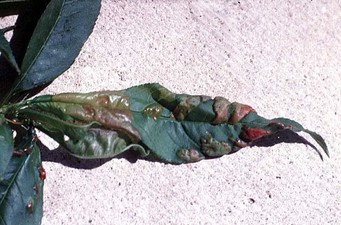
There are several fungicides labeled for this disease including chlorothalonil (Ortho Garden Disease Control, Fertilome Broad Spectrum Fungicide, GardenTech Fungicide Disease Control and Daconil). Thoroughly cover the entire tree during application. Note that it is much easier to achieve good spray coverage if the tree is pruned before spraying. (Ward Upham)
Pruning Fruit Trees
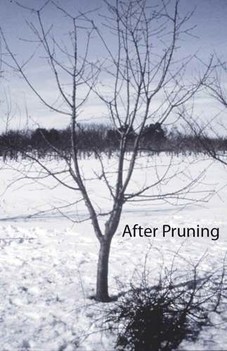
General Recommendations
- Take out broken, damaged or diseased branches
- If two branches form a narrow angle, prune one out. Narrow angles are weak angles and tend to break during wind or ice storms.
- Take out all suckers. Suckers are branches that grow straight up. They may originate from the trunk or from major branches
- If two branches cross and rub against one another, one should be taken out.
- Cut back or remove branches that are so low they interfere with harvest or pruning. If cutting back a branch, always cut back to another branch or a bud. Do not leave a stub.
- Cut back branches to reduce the total size of the tree, if necessary.
- Thin branches on the interior of the tree.
Follow the steps above in order but stop if you reach 30% of the tree. For a short video on pruning, click here.
Specific Instructions
Peach and Nectarine: Peach and nectarine require more pruning than any other fruit trees because they bear fruit on growth from the previous year. Not pruning results in fruit being borne further and further from the center of the tree allowing a heavy fruit crop to break major branches due to the weight of the fruit. Prune long branches back to a shorter side branch
Apple: Apples tend to become overgrown if not pruned regularly. Wind storms and ice storms are then more likely to cause damage. Also, trees that are not pruned often become biennial bearers. In other words, they bear a huge crop one year and none the next. Biennial bearing is caused by too many fruit on the tree. Though pruning helps, fruit often needs to be thinned as well. The goal is an apple about every 4 inches. Spacing can vary as long as the average is about every 4 inches.
Cherry, Pear, Plum: Light pruning is usually all that is needed. Simply remove branches that are causing or will cause a problem according to the general recommendations above. (Ward Upham)
Pruning Young Fruit Trees
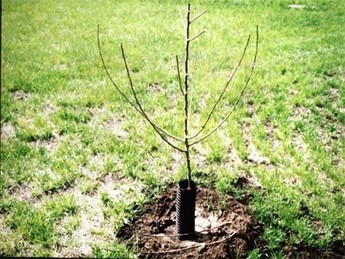
Regardless of the system used, the three to four scaffold branches should:
• Be no lower than 18 inches from the ground. This makes it easier to prune and harvest the tree once it matures.
• Form wide angles (about 60 to 80 degrees) with the trunk. Wide angles are much stronger than narrow angles and are less likely to break under wind or ice loads.
• Be distributed on different sides of the tree for good balance.
• Be spaced about 6 to 10 inches apart on the trunk with no branch directly opposite or below another. (Ward Upham)
Pruning Overgrown Apple Trees
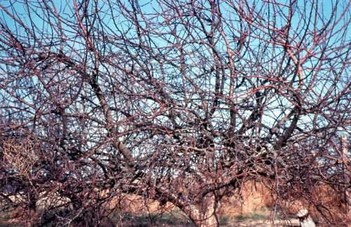
production. Overgrown apple trees are also difficult to harvest and spray. Gardeners who have such a tree are often at a loss as to how to get it back in shape.
Often the best recommendation for such a tree is to make one pruning cut at ground level and start over with a new tree. However, trees may have sentimental value that will make revitalization worth the time and effort. Realize that this will be a multi-year process because no more than 30 percent of the tree should be removed in one year. Here
are some steps to follow:
1. Remove all dead wood. This does not count toward the 30 percent.
2. Remove suckers from the base of the tree.
3. Choose approximately six of the best branches to keep as scaffold branches. Remove all others. Branches should be cut flush to the branch collar. The collar is the natural swelling that occurs where a branch connects to the trunk or to a larger branch. Removing the collar would leave a larger wound that would take additional time to heal. Do not paint wounds. Wounds heal more quickly if left open. Candidates for removal include branches with narrow crotch angles, which are more likely to break in wind and ice storms, and those that cross branches you will save. This may be all that is possible the first year if the 30 percent threshold has been reached.
4. Thin the branches on each scaffold branch. Remove crowded branches to open up the tree to light and allow humidity to escape. Shorten each scaffold branch by cutting back to a side branch. When you are through, the tree should have enough wood removed so that a softball can be thrown through the tree.
Severe pruning often will cause an apple tree to produce vigorous side shoots from the trunk called water sprouts. Main branches will also produce suckers that grow straight up. The suckers and water sprouts should be removed throughout the growing season so the center of the tree stays open. Removing water sprouts and suckers is the most time consuming and difficult practice necessary to bring an overgrown apple back into shape. (Ward Upham)
Pests:
Check Plants for Scale Insects
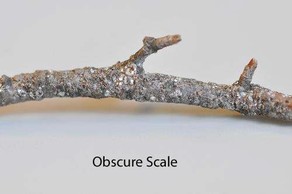
If an infestation is detected, make plans to apply a dormant oil for control by March 1. Be sure the temperature is 40 degrees or above before spraying. Scale insects are easily overlooked because they are small and immobile most of their lives and they do not resemble most other insects. Many of them resemble small shells that are oval or circular, but some have more unusual shapes like oyster shells. Coloring varies, but can include white, tan, and brown.
Plants that should be inspected for scales include apples, pears, other fruit trees, bush fruits, lilac, crabapple, oak, ash, elm, lilac, maple, linden, arborvitae, juniper, pine, spruce and yew. Manhattan euonymus, a broadleaf evergreen, is especially noted for having scale problems. Plants are not harmed if only a few scales are present. But scale population can increase dramatically during the growing season. Heavy scale infestations can damage fruit crops, destroy branches and kill entire plants. (Ward Upham)
Fungus Gnats
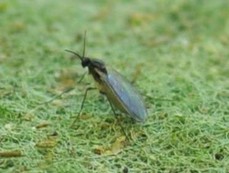
Contributors: Ward Upham, Extension Associate
 RSS Feed
RSS Feed
